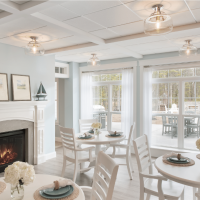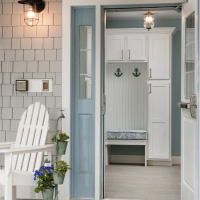Lynn Peel didn’t just want a small house-style memory care community —she wanted a small house. That’s why the standalone memory care community she runs, The Mooring on Foreside, in Cumberland Foreside, Maine, has only 12 residents.
“The number 12 was really important,” Peel, founder and principal, tells Senior Housing News. “It gave us the opportunity to still have the community feel of living amongst other people and having the group social experience, but it also afforded us the time every single day to touch every single resident individually and do something unique for them that really individualized the care they were receiving.”
After nine months of construction ending in April of 2017, the community opened in May of 2017 and reached 100% occupancy that fall. It is the 2017 Senior Housing News Architecture and Design Award winner for “Best Standalone Memory Care.” And it is giving residents deeply personalized care.
The Concept
Along with founding The Mooring on Foreside, Peel has spent the last 10 years as president of Beach Glass Transitions, LLC, a senior care advising company that helps people move into assisted living communities. The majority of her clients have dementia, and in the process of looking for the right community for these clients she heard enough feedback from family and residents that gave her a vision of a new kind of facility.
“Even with people who could afford home care, there is a certain point of people’s dementia where I just believe that residential care is more beneficial than home care because of the peer setting and the social aspect of it,” Peel says.
Peel connected with investors and developers interested in entering the memory care space, and got to work on a project that she believed was missing from the market, a smaller building licensed for 13 residents, in case they have two residents who want to live together.
The Mooring’s key break from the small house model is using only one house, as opposed to a series of houses. In small house nomenclature, each of these houses is a “pod.” The typical small house community includes multiple pods, all the same size, so that everything residents need is in their small house. Instead of using multiple pods, The Mooring has just the one.
“I did not want to put another floor or another building on this property, even though we had space to do that,” Peel says. “It was really important to me to have a truly standalone, 12-bed community, and that we were not sharing resources with another building or had any commercial space.”
With the exception of a furnace room and a storage room, all space is accessible to residents. The open kitchen allows residents to either participate in meal preparation or sit nearby while the food is made. All food is prepared in the house, with staff shopping at the local grocery store.
That is a key benefit to the site, Peel says. She chose Cumberland Foreside in Maine because it is a rural location that provides residents with privacy, serenity and nature, yet is close to the amenities of a city center, as The Mooring is 10 miles northeast of Portland, Maine.
“You drive right up to it and it looks like a house,” says Rebecca Dillon, principal of Gawron Turgeon Architects in Scarborough, Maine, which designed the building. “There is no commercial area for delivery trucks. Everything here is treated like it’s your house, brought into the building with a grocery bag. … There is no opportunity to create a more commercial-type building or activity to occur here.”
The Construction
Construction for The Mooring was scheduled for nine months, and it stayed on schedule. Peel describes the processes around zoning, entitlement and financing as “really smooth.” The biggest construction challenge was getting a building of 8,435 square feet to look from the outside like a small house.
“Lynn had some very clear direction right from the beginning,” Dillon says. “She was very clear about the fact that she wanted people to drive up to the building and see this very residential, Cape Cod home-like structure. She didn’t want to see a huge building.”
This meant ensuring that the roof line remained low enough for the structure to look like a small house while stretching far enough to cover the square footage. The next smallest standalone memory care that Dillon has designed is double the size of The Mooring.
“We had to be pretty diligent with how we laid out the footprint and how that footprint and interior of the building related to the exterior so that we could tuck it back into the back corner of the site,” Dillon says. “As you do drive up to it, you just look at this front portion that looks like a house, and you don’t realize that it goes back pretty far until you’re in there walking around.”
To connect residents to the surrounding natural landscapes, The Mooring uses a wall of windows, giving every individual bedroom at least three windows. The small house, residential feel extends to the security system’s see-through fencing, and a front door entryway that leads not to a lobby and desk, but to a mud room.
“She wanted all of the resident rooms… like you would want the bedroom in your house: to look out at the trees and the backyard,” Dillon says.
In the front of the all-wood frame structure is a homey front porch. It all adds up to an experience that respects the residents’ independence while trying to minimize their anxiety as they progress through the stages of memory loss, Dillon says.
“A lot of it comes down to the programming that they have there, but obviously we need spaces and the layouts for them to provide that programming successfully,” she says.
The house is an all-wood frame, built by Hardypond Construction in Portland, Maine. On the interior, the required emergency lighting and exit signs are intentionally discrete, again eliminating an either commercial or institutional feel.
“Those types of details that are required by code in a building like this, she really focused on those details,” Dillon says.
Peel sought to minimize the intrusiveness of those elements while building a kitchen, mud room and laundry room that feel like they belong in an individual person’s house.
“Those are what really made, I think, this project successful, and makes people feel like they are in a house as opposed to a more health care-like setting,” Dillon says. “I don’t know of any other project in the state of Maine that has only 12 beds in a standalone building. So this is pretty unique.”
The Completion
Project judge Eric Krull, executive vice president at Atlanta-based THW Design, calls the community “right-sized.”
“A lot of times I’ve got to deal with buildings that are 38 to 48 units, and they may want it under one roof,” he says. “It’s hard to take 48 units… or even 24 to 26 and create a residential-scale environment, because at some point form follows the function of moving people down corridors to programs and staff bringing services to those residents.”
Krull was impressed by the soothing feel of the interior, which is accomplished through both color and design. The overall impact helps both the resident and the visiting family members who are already under stress.
“When an institution feels like a hospital, that adds to the anxiety of a family member, but just think about what it does to the psyche of the person with dementia,” Krull says. “We all know that the environment has a big impact on their wellbeing and their ability to have a reasonable quality of life. Those are the major things that popped out at me.”
At 100% occupancy, Peel says The Mooring on Foreside has already reached a return on investment, calling the facility “a profitable endeavor.” Having only 12 residents is not the only metric that stands out. Five of the 12 residents are under 75, with the youngest just 54.
“That is obviously something that is very unique, but I think because we have a very unique offering, we attracted unique dementia cases,” Peel says.
The offering includes programming that takes residents into the surrounding community on a daily basis. The community takes van trips to local restaurants and coffee shops, and participates in the grocery shopping.
“We kind of had to shift the mindset from your traditional dementia care resident and really do some incredible programming to make sure we are honoring people who are so much younger,” Peel says. “And although these people need support because of their dementia, they can still do all of the things that the rest of us do on a day-to-day basis. And that brings a lot of value to their life here.”
Peel’s view of the successful community came during a summer barbeque, in which residents’ family members expressed joy at the care provided. They themselves were comfortable, rolling their own coolers into the backyard to sit and enjoy drinks in front of the fireplace.
“That was when I was like, ‘We did it,’” Peel says. “We made a place that feels like home to everybody.”
Written by Jack Silverstein










